BEIRUT (AP) — Islamic State group militants hunted down Syrian government troops and loyalists in the newly captured town of Palmyra, shooting or beheading them in public as a warning, and imposing their strict interpretation of Islam, activists said Friday.
The purge, which relied mostly on informants, was aimed at solidifying the extremists' grip on the strategic town that was overrun Wednesday by IS fighters.
It also was part of a campaign to win the support of President Bashar Assad's opponents, who have suffered from a government crackdown in the town and surrounding province in the last four years of Syria's civil war.
The strategy included promises to fix the electricity and water grids — after Palmyra is cleared of regime loyalists, according to an activist in the historic town. The man is known in the activist community by the nom de guerre of Omar Hamza because he fears for his security.
The capture of Palmyra has raised alarm that the militants might try to destroy one of the Mideast's most spectacular archaeological sites — a well-preserved, 2,000-year-old Roman-era city on the town's edge — as they have destroyed others in Syria and Iraq. For the moment, however, their priority appeared to be in imposing their rule, with activists saying there were no signs the group moved in on the ancient ruins.
In neighboring Iraq, IS militants made more territorial gains, seizing the small town of Husseiba, less than a week after capturing the provincial capital of Ramadi, said tribal leader Sheikh Rafie al-Fahdawi.
They captured the Iraqi side of a key border crossing with Syria on Thursday after Iraqi forces pulled out. The fall of the al-Walid crossing in Anbar province will help the militants shuttle weaponry and reinforcements more easily across the border of the two countries where they have declared a self-styled caliphate.
View gallery
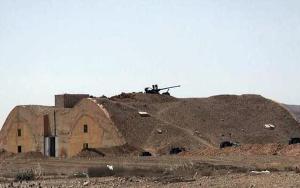
This picture released on Thursday, May 21, 2015 by the website of Islamic State militants, shows a b …
The IS militants imposed a curfew in Palmyra from 5 p.m. until sunrise and banned people from leaving town until Saturday morning to ensure that none of the government figures they seek manage to escape, activists and officials said. Jihadis went through the streets telling residents via loudspeakers not to give refuge to Assad loyalists.
IS commanders also fanned out to Palmyra's mosques to deliver sermons during Friday's weekly communal prayers. Mosques were packed after fighters on Thursday had urged people to attend and told women to cover their faces.
The sermons were mostly about the importance of performing the five-times-a-day prayers in the mosques and women having to cover their faces and dress in loose clothes, Hamza said via Skype. At the mosque where he prayed, the person delivering the sermon was a non-Syrian Arab, as were most of the leaders in the group in town, he said, while the fighters were Syrians.
In his sermon, the speaker warned that women not wearing the proper Islamic attire will be flogged.
Fighters were carrying out a bloody, door-to-door search to find and kill fugitive soldiers and known Assad loyalists, several activists said.
Prompted by the IS warnings not to provide shelter, some residents came forward with information about troops who had tried to melt into the population when the militants stormed into the town, said another activist who goes by the nom de guerre of Bebars al-Talawy for his security.
View gallery
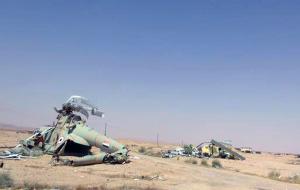
This picture released on Thursday, May 21, 2015 by the website of Islamic State militants, shows dam …
Amateur video posted on a pro-IS Facebook page showed residents and militants gathering around two bloodied men in military uniforms on a Palmyra street.
"Let all the residents see them," one of the men shown in the video told an IS fighter. Photos circulating on pro-IS Twitter feeds showed purported government troops shot to death or decapitated.
The video and photos appeared genuine and corresponded to other Associated Press reporting.
Hamza and al-Talawy said as many as 280 loyalists and government soldiers were summarily killed, some shot in the head or beheaded in a public square.
Militants abducted soldiers and pro-government gunmen from homes, shops and other places where they had sought to hide, said al-Talawy, who is based in the nearby city of Homs.
"The search is going from house to house, shop to shop, and people on the streets have to show identity cards," said Osama al-Khatib, an activist from Palmyra who is now in Turkey. Al-Khatib last contacted his friends and relatives Friday morning in Palmyra before the government cut off phones and Internet service in the town. The communication was later partially restored.
View gallery
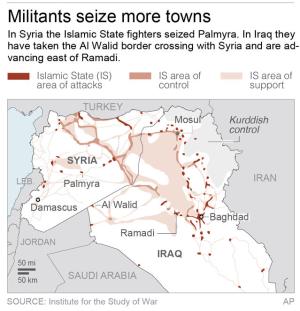
Map shows location of IS control.; 2c x 5 inches; 96.3 mm x 127 mm;
Al-Khatib said some 150 bodies lay in the streets, including 25 residents who were members of the pro-government militia known as the Popular Committees.
The door-to-door hunt was similar to a purge the militants carried out in Ramadi after it fell Sunday.
On Thursday, gunmen believed to be from IS kidnapped a Christian priest, the Rev. Jacques Mourad, from the village of Qaryatayn, southwest of Palmyra. The 48-year-old Mourad and his bodyguard were taken to an unknown location, according to a priest in in Damascus, speaking on condition of anonymity for fear of reprisals. He said the priest's computer and car also were seized.
U.N. Special Envoy for Syria Staffan de Mistura said he received with "deep sadness" the news of Mourad's abduction.
Hamza said the public killings in Palmyra appeared aimed at winning support of residents who opposed Assad's rule, and that the strategy was succeeding with some.
"People don't seem to be resentful of the new guidelines. They are saying it is much better than the regime, which used to terrorize the whole town, especially through the arrest campaigns," Hamza said.
View gallery
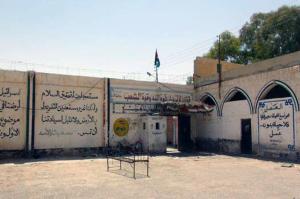
This picture released on Thursday, May 21, 2015 by the website of Islamic State militants, shows the …
He said electrical power — which had been out for 10 days as Syrian troops and Is militants battled each other — was partially restored Friday.
Hamza said there were no signs the group was moving on the ancient ruins in Palmyra, a caravan oasis that linked the civilizations of Persia, India, China with the Roman empire through trade.
Instead, IS fighters had moved into all the government buildings, he added.
But he and other activists reported that Syrian aircraft dropped barrel bombs near the military security headquarters at the northern edge of the ancient ruins. There were no reports of casualties or damage to the site.
Maamoun Abdulkarim, the head of the Antiquities and Museum Department in the Syrian capital of Damascus, said there were no gunmen in the area of Palmyra's ruins, which once attracted thousands of tourists.
But he acknowledged that "there are arrests and liquidations in Palmyra." He added that IS fighters are "moving in residential areas, terrifying people and taking revenge."
View gallery
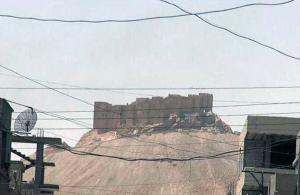
This picture released on Thursday, May 21, 2015 by the website of Islamic State militants, shows the …
Gov. Talal Barazi of the central province of Homs, which includes Palmyra, said IS fighters have abducted men and "might have committed massacres." He added that about 1,400 families fled the town of 65,000 before IS halted the exodus Thursday.
Hamza said most of those who left are regime supporters, including a clan from the neighboring Deir el-Zour province that had been based in Palmyra to help defend the government.
The Britain-based Syrian Observatory for Human Rights and al-Talawy said the next target for IS appears to be the Tayfour air base near Palmyra, where many government troops had retreated. They said the militants were moving reinforcements to the area.
Activists al-Talawy and al-Khatib said IS had also captured the phosphate mines at Khunayfis, near Palmyra.
The town of Husseiba in Iraq's Anbar province had fallen overnight to IS forces when police and tribal fighters withdrew after running out of ammunition, said al-Fahdawi, the tribal leader.
"We have not received any assistance from the government. Our men fought to the last bullet and several of them were killed," he told the AP in a telephone interview.
View gallery
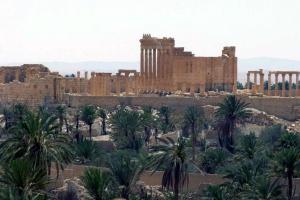
This file photo released on Sunday, May 17, 2015, by the Syrian official news agency SANA shows the …
Husseiba is about 7 kilometers (4 miles) east of Ramadi, where IS militants routed Iraqi forces in their most significant advance in nearly a year.
Al-Fahdawi said that with the fall of Husseiba, the militants have moved closer to the strategic Habbaniyah military base, which is still held by Iraqi forces.
The U.N. World Food Program said it is rushing food assistance into Anbar province to help tens of thousands of residents who have fled the latest fighting.
About 25,000 people received emergency food assistance Thursday, and supplies for an additional 15,000 displaced people were en route to another area near the militant-held city of Fallujah, the WFP said.
The Iraqi government plans to launch a counteroffensive in Anbar involving Iranian-backed Shiite militias, which have played a key role in pushing back IS militants elsewhere in the country. The presence of the militias could fuel sectarian tensions in the overwhelmingly Sunni province, where anger and mistrust toward the Shiite-led government runs deep.
In Washington, U.S. defense officials said Iran has entered the fight to retake a major Iraqi oil refinery in Beiji from IS militants, contributing small numbers of troops — including some operating artillery and other heavy weapons — in support of advancing Iraqi ground forces.
Two U.S. defense officials said Iranian forces have taken a significant offensive role in the Beiji operation in recent days, in conjunction with Iraqi Shiite militia. The officials were not authorized to discuss the matter publicly and spoke on condition of anonymity.
Iran's role in Iraq is a major complicating factor for the U.S. as it searches for the most effective approach to countering the Islamic State group. U.S. officials have said they do not oppose contributions from Iran-supported Iraqi Shiite militias as long as they operate under the command and control of the Iraqi government.
The U.S. has been leading a coalition that has been conducting airstrikes against IS militants in Iraq and Syria.
___
Associated Press writers Sameer N. Yacoub in Baghdad and Robert Burns in Washington contributed to this report.